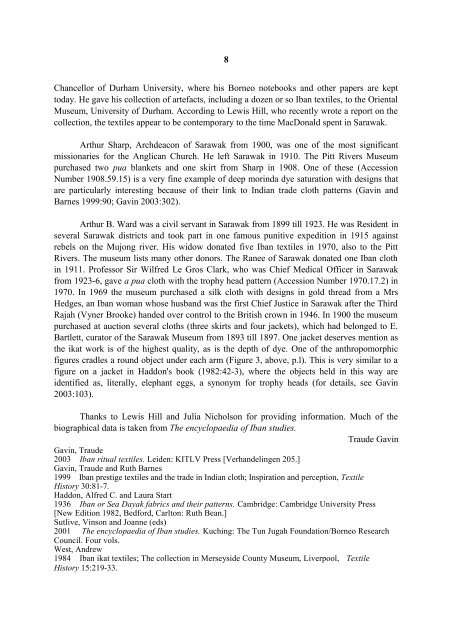download - OATG. Oxford Asian Textile Group
download - OATG. Oxford Asian Textile Group
download - OATG. Oxford Asian Textile Group
You also want an ePaper? Increase the reach of your titles
YUMPU automatically turns print PDFs into web optimized ePapers that Google loves.
8<br />
Chancellor of Durham University, where his Borneo notebooks and other papers are kept<br />
today. He gave his collection of artefacts, including a dozen or so Iban textiles, to the Oriental<br />
Museum, University of Durham. According to Lewis Hill, who recently wrote a report on the<br />
collection, the textiles appear to be contemporary to the time MacDonald spent in Sarawak.<br />
Arthur Sharp, Archdeacon of Sarawak from 1900, was one of the most significant<br />
missionaries for the Anglican Church. He left Sarawak in 1910. The Pitt Rivers Museum<br />
purchased two pua blankets and one skirt from Sharp in 1908. One of these (Accession<br />
Number 1908.59.15) is a very fine example of deep morinda dye saturation with designs that<br />
are particularly interesting because of their link to Indian trade cloth patterns (Gavin and<br />
Barnes 1999:90; Gavin 2003:302).<br />
Arthur B. Ward was a civil servant in Sarawak from 1899 till 1923. He was Resident in<br />
several Sarawak districts and took part in one famous punitive expedition in 1915 against<br />
rebels on the Mujong river. His widow donated five Iban textiles in 1970, also to the Pitt<br />
Rivers. The museum lists many other donors. The Ranee of Sarawak donated one Iban cloth<br />
in 1911. Professor Sir Wilfred Le Gros Clark, who was Chief Medical Officer in Sarawak<br />
from 1923-6, gave a pua cloth with the trophy head pattern (Accession Number 1970.17.2) in<br />
1970. In 1969 the museum purchased a silk cloth with designs in gold thread from a Mrs<br />
Hedges, an Iban woman whose husband was the first Chief Justice in Sarawak after the Third<br />
Rajah (Vyner Brooke) handed over control to the British crown in 1946. In 1900 the museum<br />
purchased at auction several cloths (three skirts and four jackets), which had belonged to E.<br />
Bartlett, curator of the Sarawak Museum from 1893 till 1897. One jacket deserves mention as<br />
the ikat work is of the highest quality, as is the depth of dye. One of the anthropomorphic<br />
figures cradles a round object under each arm (Figure 3, above, p.l). This is very similar to a<br />
figure on a jacket in Haddon's book (1982:42-3), where the objects held in this way are<br />
identified as, literally, elephant eggs, a synonym for trophy heads (for details, see Gavin<br />
2003:103).<br />
Thanks to Lewis Hill and Julia Nicholson for providing information. Much of the<br />
biographical data is taken from The encyclopaedia of Iban studies.<br />
Traude Gavin<br />
Gavin, Traude<br />
2003 Iban ritual textiles. Leiden: KITLV Press [Verhandelingen 205.]<br />
Gavin, Traude and Ruth Barnes<br />
1999 Iban prestige textiles and the trade in Indian cloth; Inspiration and perception, <strong>Textile</strong><br />
History 30:81-7.<br />
Haddon, Alfred C. and Laura Start<br />
1936 Iban or Sea Dayak fabrics and their patterns. Cambridge: Cambridge University Press<br />
[New Edition 1982, Bedford, Carlton: Ruth Bean.]<br />
Sutlive, Vinson and Joanne (eds)<br />
2001 The encyclopaedia of Iban studies. Kuching: The Tun Jugah Foundation/Borneo Research<br />
Council. Four vols.<br />
West, Andrew<br />
1984 Iban ikat textiles; The collection in Merseyside County Museum, Liverpool, <strong>Textile</strong><br />
History 15:219-33.
















